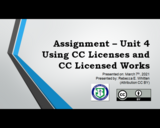
Using CC Licenses & CC Licensed Works
- Subject:
- Applied Science
- Information Science
- Material Type:
- Lecture Notes
- Author:
- Rebecca E. Whitten
- Date Added:
- 04/12/2021

Agriculture | Architecture and Design | Engineering

Using CC Licenses & CC Licensed Works
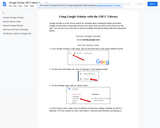
Handout about searching Google Scholar, adding library links, and finding full text.
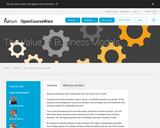
Does your business need a make-over? Are you unsure how to start?
Having an innovative business model is key for a profitable business and growth. In this business and management course, you will learn how to design, test and implement new business models for sustainable success.
This course introduces you to the main topics of business model innovation. You will learn what drives business model innovation and why it is valuable to you and your business. You will apply practical tools to (re)design and test a business model.
Be inspired by real-life business model examples from fellow entrepreneurs and learn from leading experts who design business model innovations. By the end of this course, you will be able to structure your thinking and communicate your business model ideas and learn how to improve your own business.
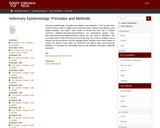
The purpose of this textbook is to provide an introductory, yet comprehensive, source of information on epidemiology for veterinary students, researchers, and practitioners. There has not been a textbook that presents analytic epidemiology as a science, basic to veterinary medicine's efforts in health management (herd health) as well as in clinical medicine.

Short Description:
The purpose of this textbook is to help learners develop best practices in vital sign measurement. Using a multi-media approach, it will provide opportunities to read about, observe, practice, and test vital sign measurement.
Long Description:
The purpose of this textbook is to help learners develop best practices in vital sign measurement. Using a multi-media approach, it will provide opportunities to read about, observe, practice, and test vital sign measurement. Boxes with helpful tips are provided throughout the chapters: Technique Tips provide helpful information about measurement techniques, and Points to Consider highlight key points to consider about vital sign measurements and findings.
A Chapter Summary and Printable Flashcards highlighting techniques for each vital sign measurement are provided at the end of each chapter. These printable flashcards are all located together in the textbook’s conclusion chapter.
Learners can review the full textbook or advance to sections that they have identified as areas to work on. The textbook has a self-directed format and provides an interactive and engaging way for learners to develop competence in the measurement of vital signs while integrating knowledge about anatomy and physiology.
Learners will develop knowledge about various vital signs including temperature, pulse, respiration, blood pressure, and oxygen saturation. Measurement of vital signs is a foundational, psychomotor skill for healthcare providers and students in post-secondary health-related programs such as nursing, medicine, pharmacy, midwifery, paramedics, physiotherapy, occupational therapy, and massage therapy. These measurements provide information about a person’s overall state of health and more specifically about their cardiovascular and respiratory status. These measurements can also reveal changes in a client’s vital signs over time and changes in their overall state of health. Proficiency in vital sign measurement is essential to client safety, care, and management. Measurements can influence clinical decision-making related to therapeutic interventions.
Word Count: 28583
(Note: This resource's metadata has been created automatically by reformatting and/or combining the information that the author initially provided as part of a bulk import process.)

Paras Saluja, inspired by plastic waste innovations across the globe, decided to upcycle discarded plastic chairs, buckets, toys etc. into heavy-duty tiles w...
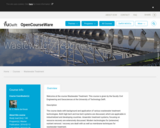
Welcome at the course Wastewater Treatment. This course is given by the faculty Civil Engineering and Geosciences at the University of Technology Delft.
Description
The course deals with background and application of various wastewater treatment technologies. Both high-tech and low-tech systems are discussed, which are applicable in industrialized and developing countries. Anaerobic treatment systems, focusing on resource recovery are extensively discussed. Modern technologies for (extensive) nutrient removal / recovery are dealt with as well as membrane techniques for wastewater treatment.

Master course on design and planning of the urban water management system. It deals with fluxes and processes in water and soil. Furthermore, aspects of water management policy development are discussed.

Students will explore the engineering challenges of providing access to clean water, identify the issues surrounding clean water, listen to experts, and learn about future work
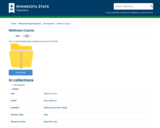
This is a downloadable object of filetype zip and size 59.98 MB.
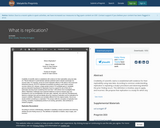
Replications are inevitably different from the original studies. How do we decide whether something is a replication? The answer shifts the conception of replication from a boring, uncreative, housekeeping activity to an exciting, generative, vital contributor to research progress.

In dit college worden structuren uit de wiskunde behandeld, zoals natuurlijke getallen en inductie, reële getallen en volledigheid, functies en continuïteit, convergentie van getallenrijen, functierijen en getallenreeksen. Het doel hiervan is niet zozeer het leren van rekenvaardigheden in de analyse, maar meer het begrijpen van de theorie daarachter, in het bijzonder het leren omgaan met definities, stellingen en bewijzen. Hiermee wordt een stevig fundament gelegd voor verdere studie in de wiskunde.
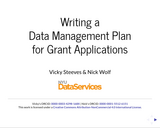
A class covering the basics of writing a successful data management plan for federal funding agencies such as the NEH, NSF, NIH, NASA, and others.
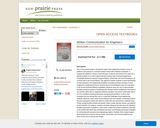
This course packet seeks to develop the upper level engineering student’s sense of audience and purpose in a research-based context with workplace constraints. It requires the student to choose a technical topic of interest and research it to solve for a specific problem or to meet a typical industry need by way of several assignments: Unsolicited Research Proposal, Progress Report, Visual Aids, and Oral Presentation, all of which lead to the Formal Report. This approach readies students to write informatively and persuasively in the engineering workplace, providing excellent examples of each assignment contributed by former students whose Formal Reports have won first place in the annual Technical Writing Competition. Because users can rely on demonstrably excellent student examples to understand the concepts behind assignments that build on one another rather than on disparate textbook examples, they tend to write better and to be more confident producing documents and giving presentations. In short, they recognize they are among their own in a class that challenges many engineering students. Moreover, since all the Formal Reports have won awards, convincing students they are using good models with which to create their own documents is relatively easy. Finally, mining excellent student documents makes certain skill-sets clearer, according to former students. For instance, students can follow along as the writer does the following: identifies and proves a problem or need exists; creates the research objectives that lead to the method with which they will address the issue; and develops persuasive strategies for convincing both executive and engineering readers. Similarly, these student papers demonstrate how to discern among results, conclusions, and recommendations and show correct use of sources and visuals.

Reduction of energy consumption of buildings is an important step in the move towards a sustainable economy. How can buildings be made net zero energy, in different climates?
This course introduces you to zero energy design. It will teach you a stepped approach to design a zero energy climate concept for existing buildings: homes, schools, offices, shops etc. It will demonstrate how an integrated approach, which takes into account both passive measures (such as thermal insulation and sun shading) and active measures (such as heat pumps and photovoltaic panels), can deliver the best results.
It will do so by providing you with an overview of possible measures, and through reviewing several case studies of zero energy buildings in the Netherlands, with lessons for other climates as well. Thus, you will learn which measures are most suitable for individual buildings under local climate conditions.
This course is for anyone interested in making buildings more energy efficient, who already possess basic technical knowledge.